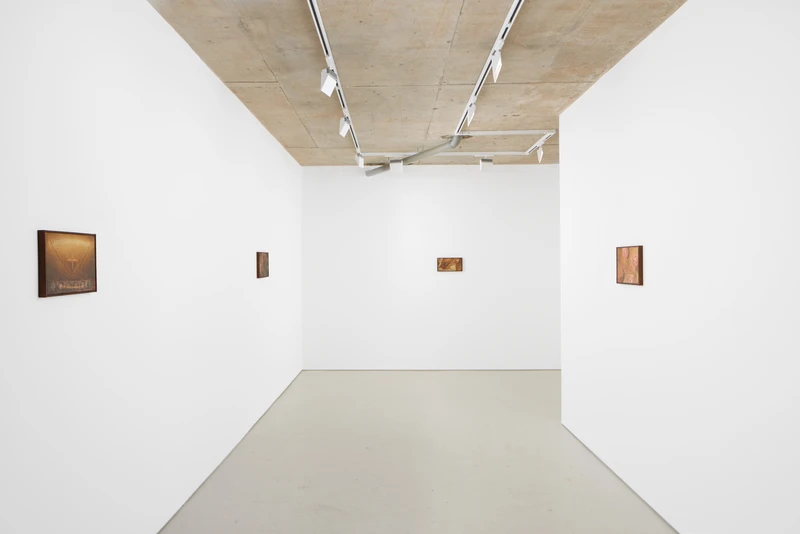Rafal Topolewski: Interludes
23 Nov 2023-13 Jan 2024
PV 23 Nov 2023, 6-8pm


The group of recent paintings that make up Rafal Topolewski’s solo exhibition, ‘Interludes’, evoke the hallucinatory quality of dreams and the sensation of things half-remembered or forgotten. They resonate with the unsettled feeling of being caught in a moment that doesn’t belong fully to one time or another, one place or another.
Rendered predominantly in sombre earth tones, the subjects in the paintings all appear to occupy dimly lit environments. Everything seems frozen in a condition of semi-darkness and taken together with the depictions of faces, which share a vacant expression suggestive of a mind not wholly present, we might interpret this as a visual representation of, or equivalent to, a state of semi-consciousness. A work showing a pillow supporting an ambiguous object standing in for a head makes another, more explicit, association between the indeterminate formal gloom and the liminal mental state between sleeping and waking. In other paintings, the out-of-joint logic of a state such as this takes the form of jarring bricolages: a thistle is superimposed in front of an eye; a face, dissected by a linear structure partially recalled from an earlier painting, looms behind or sinks into a dark sea; flowers and black droplets hover, suspended, against an undefined background. The combination of awkwardly cropped fragments, together with an atmosphere of muffled interiority, reproduces something of the uncanny way things get mixed up in dreams and can feel equally symbolic. But although one might guess at what is being symbolised — perhaps a fear of blindness or even death — ultimately, what is transposed, is a feeling of uneasiness.
In addition to repeated flower and eye motifs, as well as the murky colour palette, what the works most obviously share is a tentative painterly touch, a deliberate registering of doubt. The way the images are painted is kind of fuzzy, neither sharp nor fully out of focus. The dry brushwork produces a comparable quality to that of a grainy photograph, a degraded digital file, or something else worn out by time. This quality of things slightly blurred, slightly distant, is used to embody not only the likeness of absent or past things but the act of recalling itself.
To construct or re-construct pictures, Topolewski draws on his archive of personal photographs as well as images found in books and on the internet. This source material gets cut up, manipulated and merged in preparatory digital collages, which serve as a point of departure. Once a painting is begun, however, it is pursued on its own terms and can transform, through the activity of painting, into something previously unknown. Although second-hand images often play a crucial part in the process of creation, the inclusion of the artist’s image — all the faces represented are self-portraits — seems to indicate that, regardless of where pictorial elements originate, Topolewski is primarily concerned with interrogating his own psychological space and the intimate scale of the works reinforces the suggestion of a private individual space. The subjects belong, after all, to a personal repository of images and forms.
Interludes, like memories, occupy a space in time between things and are defined by their absence. They are paradoxically absent in the present. For Topolewski, this idea of materialising a moment of suspension between one state and another is central, not only to the way something is depicted or contained within the bounded surface of a painting but to the uncertainties from which the work emerges. It describes the task that most profoundly shapes the artist’s work: that of making tangible and picking at the seams between consciousness and unconsciousness, clarity and confusion, meaning and meaninglessness.
Text by Neill Kidgell